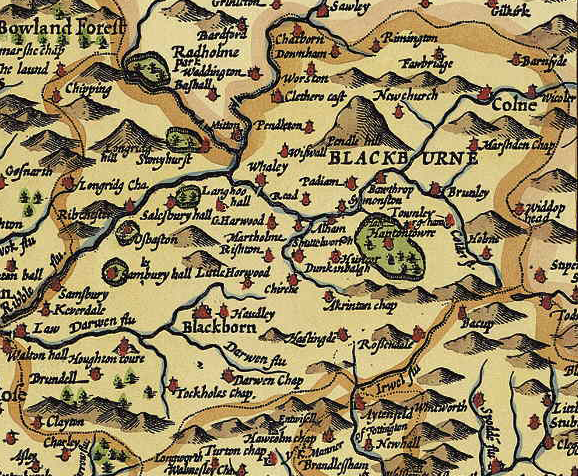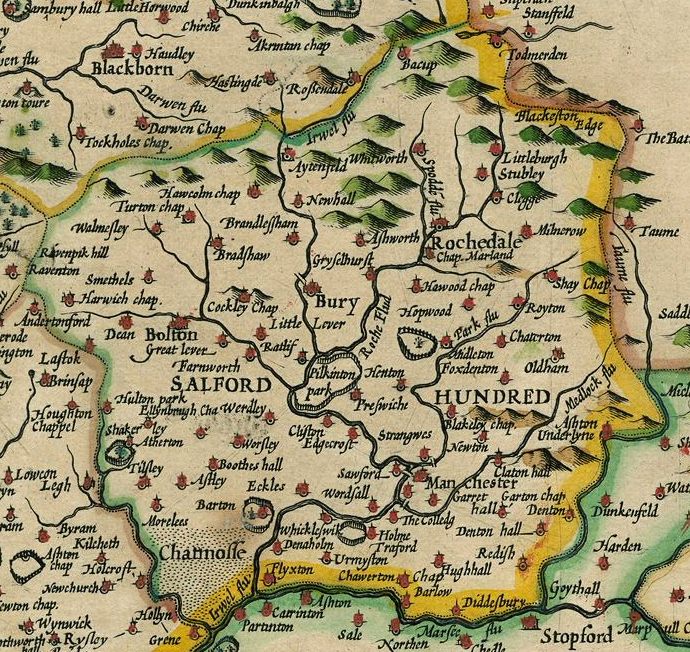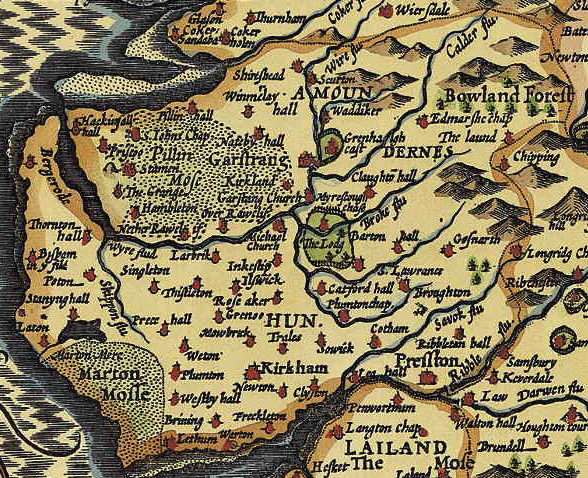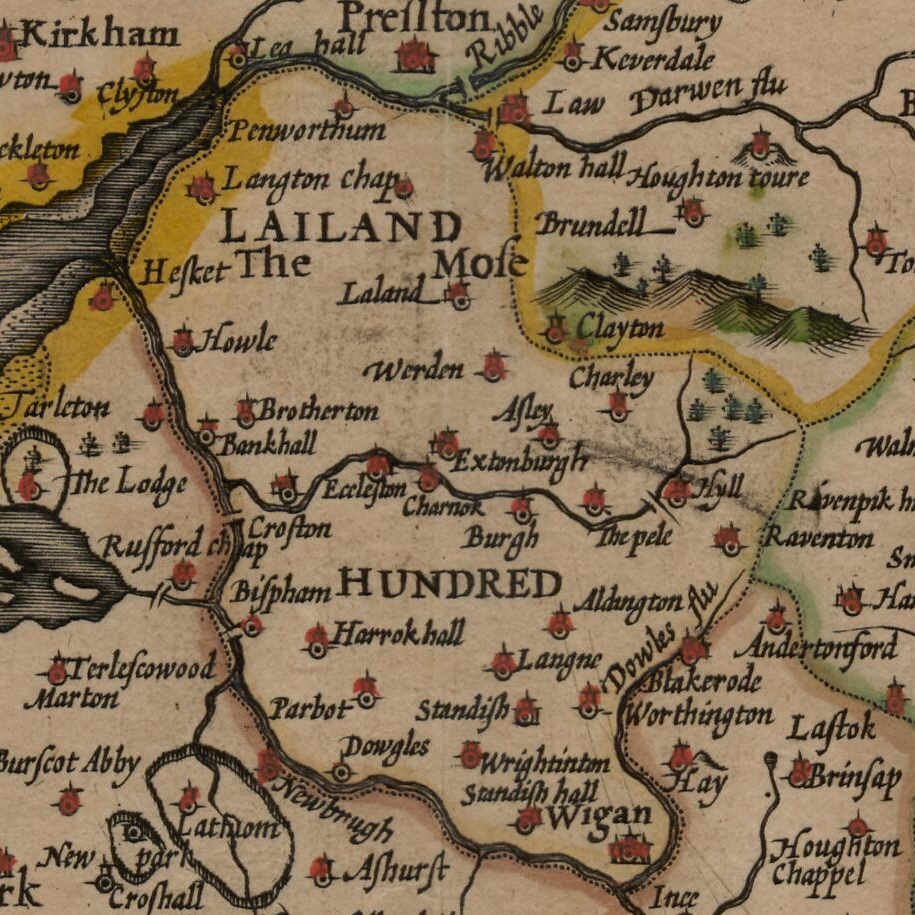|
Apostolic Vicariate Of Lancashire District
The Apostolic Vicariate of the Lancashire District was an ecclesiastical jurisdiction of the Roman Catholic Church in England and Wales, Catholic Church in England. It was led by a vicar apostolic who was a titular bishop. The apostolic vicariate was created in 1840 and was replaced by two dioceses in 1850. History The Apostolic Vicariate of the Lancashire District was created out of the Apostolic Vicariate of the Northern District (England), Northern District on 11 May 1840. The Lancashire District comprised the Historic counties of England, historic counties of Lancashire and Cheshire, plus the Isle of Man. The vicar apostolic of the district was Bishop George Hilary Brown, who was appointed on 5 June 1840. Three years later, Bishop James Sharples (bishop), James Sharples was appointed coadjutor vicar apostolic on 7 August 1843 to assist Bishop Brown in overseeing the district. On the Universalis Ecclesiae, restoration of the hierarchy in England and Wales by Pope Pius IX on 2 ... [...More Info...] [...Related Items...] OR: [Wikipedia] [Google] [Baidu] |
England
England is a country that is part of the United Kingdom. It shares land borders with Wales to its west and Scotland to its north. The Irish Sea lies northwest and the Celtic Sea to the southwest. It is separated from continental Europe by the North Sea to the east and the English Channel to the south. The country covers five-eighths of the island of Great Britain, which lies in the North Atlantic, and includes over 100 smaller islands, such as the Isles of Scilly and the Isle of Wight. The area now called England was first inhabited by modern humans during the Upper Paleolithic period, but takes its name from the Angles, a Germanic tribe deriving its name from the Anglia peninsula, who settled during the 5th and 6th centuries. England became a unified state in the 10th century and has had a significant cultural and legal impact on the wider world since the Age of Discovery, which began during the 15th century. The English language, the Anglican Church, and Engli ... [...More Info...] [...Related Items...] OR: [Wikipedia] [Google] [Baidu] |
Historic Counties Of England
The historic counties of England are areas that were established for administration by the Normans, in many cases based on earlier Heptarchy, kingdoms and shires created by the Angles, Saxons, Jutes, Celts and others. They are alternatively known as ancient counties, traditional counties, former counties or simply as counties. In the centuries that followed their establishment, as well as their administrative function, the counties also helped define local culture and identity. This role continued even after the counties ceased to be used for administration after the creation of Administrative counties of England, administrative counties in 1889, which were themselves amended by further local government reforms in the years following. Unlike the partly self-governing Ancient borough, boroughs that covered urban areas, the counties of medieval England existed primarily as a means of enforcing central government power, enabling monarchs to exercise control over local areas throug ... [...More Info...] [...Related Items...] OR: [Wikipedia] [Google] [Baidu] |
Roman Catholic Diocese Of Shrewsbury
The Roman Catholic Diocese of Shrewsbury is a Roman Catholic diocese in the Province of Birmingham which encompasses the pre-1974 counties of Shropshire and Cheshire in the North West and West Midlands of England. The diocese includes rural areas of Shropshire as well as Manchester south of the River Mersey and other urban areas such as Birkenhead, Stockport and Ellesmere Port. The current bishop, Mark Davies, succeeded on 1 October 2010.Bishop Mark Davies ''Catholic Hierarchy''. Retrieved on 12 March 2010. Geographical location The comprises the counties of |
Blackburnshire
Blackburn Hundred (also known as Blackburnshire) is a historic sub-division of the county of Lancashire, in northern England. Its chief town was Blackburn, in the southwest of the hundred. It covered an area similar to modern East Lancashire, including the current districts of Ribble Valley (excluding the part north of the River Ribble and east of the Hodder, which was then in Yorkshire), Pendle (excluding West Craven, also in Yorkshire), Burnley, Rossendale, Hyndburn, Blackburn with Darwen, and South Ribble (east from Walton-le-dale and Lostock Hall). Much of the area is hilly, bordering on the Pennines, with Pendle Hill in the midst of it, and was historically sparsely populated. It included several important royal forests. In the 18th century several towns in the area became industrialized and densely populated, including Blackburn itself, and Burnley. Early history The shire probably originated as a county of the Kingdom of Northumbria, but was much fought over. In the Do ... [...More Info...] [...Related Items...] OR: [Wikipedia] [Google] [Baidu] |
Salford (hundred)
The Salford Hundred (also known as Salfordshire) was one of the subdivisions of the historic county of Lancashire, in Northern England (see:Hundred (county division). Its name alludes to its judicial centre being the township of Salford (the suffix ''-shire'' meaning the territory was appropriated to the prefixed settlement). It was also known as the Royal Manor of Salford and the Salford wapentake.. Origins The Manor or Hundred of Salford had Anglo-Saxon origins. The ''Domesday Book'' recorded that the area was held in 1066 by Edward the Confessor. Salford was recorded as part of the territory of ''Inter Ripam et Mersam'' or "Between Ribble and Mersey", and it was included with the information about Cheshire, though it cannot be said clearly to have been part of Cheshire. The area became a subdivision of the County Palatine of Lancaster (or Lancashire) on its creation in 1182. Salford Hundred Court In spite of its incorporation into Lancashire, Salford Hundred retained a se ... [...More Info...] [...Related Items...] OR: [Wikipedia] [Google] [Baidu] |
Amounderness
The Amounderness Hundred () is one of the six subdivisions of the historic county of Lancashire in North West England, but the name is older than the system of hundreds first recorded in the 13th century and might best be described as the name of a Norse wapentake. In the Domesday Book, it was used for some territories north of the River Ribble included together with parts of Yorkshire. The area eventually became part of Lancashire, sitting geographically between the Rivers Lune and Ribble, in the strip of coast between the Irish Sea and Bowland Forest. Etymology and history In the 19th century, the name was considered to have been first recorded in 705, as Hacmunderness. The Domesday Book in 1086 spells it Agemundrenessa. There are two suggested etymologies for Amounderness. The traditional 19th century reading was that the name derived from ''ac'' (oak) and ''mund'' (protection), "a ness or promontory sheltered by oaks". This was given currency by Porter.Porter, J, ''A His ... [...More Info...] [...Related Items...] OR: [Wikipedia] [Google] [Baidu] |
Lonsdale (hundred)
The Lonsdale Hundred is an historic hundred of Lancashire, England. Although named after the dale or valley of the River Lune, which runs through the city of Lancaster, for centuries it covered most of the north-western part of Lancashire around Morecambe Bay, including the detached parts of Furness and the Cartmel Peninsula. Ironically, only some of the detached part of North Lonsdale still remains partly within a British parliamentary constituency under the name of Lonsdale, being part of the Westmorland and Lonsdale constituency. Lonsdale was not recorded as a hundred in the Domesday Book, but the name does appear, in the returns for Yorkshire, apparently as a manor attached to Cockerham. A number of places within the Lune's watershed are traditionally named with specification of 'in Lonsdale': Kirkby Lonsdale, Burton-in-Lonsdale, and Thornton-in-Lonsdale retain the name, while Middleton, Sedbergh, Ingleton and Newby, near Clapham have previously been recorded with it. F ... [...More Info...] [...Related Items...] OR: [Wikipedia] [Google] [Baidu] |
Leyland (hundred)
The Leyland Hundred (also known as Leylandshire) is a historic subdivision of the English county of Lancashire. It covered the parishes of Brindle, Chorley, Croston, Eccleston, Hoole, Leyland, Penwortham, Rufford, Standish and Tarleton. In the Domesday Book the area was recorded as 'Lailand' Hundred, with Chorley Parish in Warmundestrou Hundred and Eccleston Parish in Duddeston Hundred, all included in the returns for Cheshire Cheshire ( ) is a ceremonial and historic county in North West England, bordered by Wales to the west, Merseyside and Greater Manchester to the north, Derbyshire to the east, and Staffordshire and Shropshire to the south. Cheshire's county t .... However, it cannot be said clearly to have been part of Cheshire.Crosby, A. (1996). writes on page 31: Notes and references Bibliography *Crosby, A. (1996). ''A History of Cheshire.'' (The Darwen County History Series.) Chichester, West Sussex, UK: Phillimore & Co. Ltd. . *Harris, B. E., and Thac ... [...More Info...] [...Related Items...] OR: [Wikipedia] [Google] [Baidu] |
West Derby (hundred)
The West Derby Hundred (also known as West Derbyshire) is one of the six subdivisions of the historic county of Lancashire, in northern England. Its name alludes to its judicial centre being the township of West Derby (the suffix ''- shire'' meaning the territory was appropriated to the prefixed settlement). It covered the southwest of Lancashire, containing the ancient ecclesiastical parishes of Walton, Sefton, Childwall, Huyton, Halsall, Altcar, North Meols, Ormskirk, Aughton, Warrington, Prescot, Wigan, Leigh, Liverpool, and Winwick. It corresponds roughly to areas of Merseyside north of the River Mersey and also covered parts of modern West Lancashire Borough, Wigan borough, Warrington Borough and Halton Borough. History Domesday Book When the ''Domesday Book'' was compiled, this hundred was composed of three separate hundreds of West Derby, [...More Info...] [...Related Items...] OR: [Wikipedia] [Google] [Baidu] |
Hundred (county Subdivision)
A hundred is an administrative division that is geographically part of a larger region. It was formerly used in England, Wales, some parts of the United States, Denmark, Southern Schleswig, Sweden, Finland, Norway, the Bishopric of Ösel–Wiek, Curonia, the Ukrainian state of the Cossack Hetmanate and in Cumberland County, New South Wales, Cumberland County in the British Colony of New South Wales. It is still used in other places, including in Australia (in South Australia and the Northern Territory). Other terms for the hundred in English and other languages include ''#wapentake, wapentake'', ''herred'' (Danish and Bokmål, Bokmål Norwegian), ''herad'' (Nynorsk, Nynorsk Norwegian), ''hérað'' (Icelandic), ''härad'' or ''hundare'' (Swedish), ''Harde'' (German), ''hiird'' (North Frisian language, North Frisian), ''satakunta'' or ''kihlakunta'' (Finnish), ''kihelkond'' (Estonian), ''kiligunda'' (Livonian), ''cantref'' (Welsh) and ''sotnia'' (Slavic). In Ireland, a similar subdi ... [...More Info...] [...Related Items...] OR: [Wikipedia] [Google] [Baidu] |
Roman Catholic Diocese Of Salford
The Roman Catholic Diocese of Salford is centred on the City of Salford in Greater Manchester, England. The diocese was founded in 1852 as one of the first post-Reformation Catholic dioceses in Great Britain. Since 1911 it has formed part of the Province of Liverpool. Its current boundaries encompass Manchester and a large part of North West England, between the River Mersey and the River Ribble, as well as some parishes north of the Ribble and Todmorden in Calderdale, West Yorkshire. Stonyhurst College is also within the diocese. In 2005, the diocese included 207 churches and chapels. History The first post-Reformation Catholic chapel in Blackburn was opened in 1773, and that in Manchester in 1774 (in Rook Street, dedicated to St Chad). In 1843 the Rev. James Sharples, rector of St. Alban's, Blackburn, was consecrated Titular Bishop of Samaria and appointed coadjutor to Bishop Brown, the first Vicar Apostolic of the Lancashire District. He built at Salford St. John's Church, ... [...More Info...] [...Related Items...] OR: [Wikipedia] [Google] [Baidu] |
Roman Catholic Archdiocese Of Liverpool
The Catholic Archdiocese of Liverpool ( la, Archidioecesis Liverpolitana) is an archdiocese of the Catholic Church that covers the Isle of Man and part of North West England. The episcopal see is Liverpool Metropolitan Cathedral. The archdiocese is the centre of the Ecclesiastical Province of Liverpool which covers the north of England as well as the Isle of Man. History With the gradual abolition of the legal restrictions on the activities of Roman Catholics in England and Wales in the early 19th century, Rome decided to proceed to bridge the gap of the centuries from Queen Elizabeth I by instituting Catholic dioceses on the regular historical pattern. Thus Pope Pius IX issued the Bull ''Universalis Ecclesiae'' of 29 September 1850 by which thirteen new dioceses which did not formally claim any continuity with the pre-Elizabethan English dioceses were created. One of these was the diocese of Liverpool. Initially it comprised the Hundreds of West Derby, Leyland, Fylde, Amound ... [...More Info...] [...Related Items...] OR: [Wikipedia] [Google] [Baidu] |






.jpg)